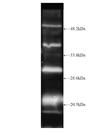Product Details
| Alternative Name: | Proteasome subunit β type-10, Macropain subunit MECl-1 |
| |
| Host: | Rabbit |
| |
| Immunogen: | Synthetic peptide corresponding to aa 218-236 of mouse proteasome 20S (β2i subunit). |
| |
| UniProt ID: | O35955 (mouse), P40306 (human) |
| |
| Gene/Protein Identifier: | PSMB10 (gene name) |
| |
| Species reactivity: | Human, Mouse
|
| |
| Specificity: | Recognizes the β2i subunit of the 20S proteasome. |
| |
| Applications: | IF, IHC, WB
|
| |
| Application Notes: | Western blot: The serum was characterised by single dimension SDS-PAGE against murine derived proteasomal preparations followed by Western blotting. A protein of ~29kDa was detected using the antibody at a dilution of 1:500-1:1000 using enhanced chemiluminescent detection. When a mouse liver cell derived lysate is probed a number of protein bands are observed in addition to that at ~29kDa. |
| |
| Formulation: | Liquid. Antiserum containing 10mM sodium azide. |
| |
| Use/Stability: | Store unopened vial at -20°C until required for use. AVOID REPEATED FREEZE-THAW CYCLES. Aliquot undiluted antibody into smaller volumes (not less than 10μL) prior to freezing if appropriate. The use of high quality ‘antiserum-grade’ plastic or glass vials is recommended. Store diluted antibody at 2-4°C (do not freeze) and use within 1 month. Dilute to working strength with phosphate buffered saline pH 7.2-7.4 and 1% normal goat serum (if a goat anti-rabbit IgG linker antibody is to be used). |
| |
| Shipping: | Blue Ice |
| |
| Long Term Storage: | -20°C |
| |
| Scientific Background: | The proteasome is widely recognised as the central enzyme of non-lysosomal protein degradation. It is responsible for intracellular protein turnover and it is also critically involved in many regulatory processes and, in higher eukaryotes, in antigen processing. The 26S proteasome is the key enzyme of the ubiquitin/ATP-dependent pathway of protein degradation. The catalytic core of this unusually large (2000kDa, 450Å in length) complex is formed by the 20S proteasome, a barrel shaped structure shown by electron microscopy to comprise of four rings each containing seven subunits. Based on sequence similarity, all fourteen 20S proteasomal subunit sequences may be classified into two groups, α and β, each group having distinct structural and functional roles. The α-subunits comprise the outer rings and the β-subunits the inner rings of the 20S proteasome. Observations of the eukaryotic proteasome and analysis of subunit sequences indicate that each ring contains seven different subunits (α7β7β7α7) with a member of each sub-family represented in each particle. Each subunit is located in a unique position within the α- or β-rings. Lmp2, Lmp7 and MECL are interferon gamma-inducible catalytic subunits of the 20S proteasome which may replace the constitutive catalytic subunits, delta, X and Z respectively, during proteasome biogenesis. Lmp2 and Lmp7 alter the cleavage site specificity of the 20S proteasome and are required for the efficient generation of T cell epitopes from a number of viral proteins and for optimal MHC class I cell surface expression. |
| |
| Technical Info/Product Notes: | Species reactivity: This antibody has been shown to react with mouse derived material but it only reacts very weakly, if at all, with the human subunit.
Various systems for the nomenclature of the proteasome subunits have been established. This may be a source of confusion as the system on UniProt differs from "standard" nomenclature as described in the literature. The UniProt ID and Gene Name will help to clearly identify the proteins. |
| |
| Regulatory Status: | RUO - Research Use Only |
| |

Western Blot Analysis: Luminograph of mouse liver cell lysate after SDS-PAGE followed by blotting onto PVDF and probing with antibody (Prod. No. BML-PW8150). Antibody dilution 1:500 using ECL procedure (30 second exposure).
Please mouse over
Product Literature References
Circadian modulation of proteasome activity and accumulation of oxidized protein in human embryonic kidney HEK 293 cells and primary dermal fibroblasts: A. Desvergne, et al.; Free Radic. Biol. Med.
94, 195 (2016),
Application(s): Western blot,
Abstract;
Persistent hijacking of brain proteasomes in HIV-associated dementia: T.P. Nguyen, et al.; Am. J. Pathol.
176, 893 (2010),
Application(s): Western blot,
Abstract;
Full Text
The immunoproteasome, the 20S proteasome and the PA28αβ proteasome regulator are oxidative-stress-adaptive proteolytic complexes: A.M. Pickering, et al.; Biochem. J.
432, 585 (2010),
Application(s): Western blot,
Abstract;
Full Text
Proteasomal interference prevents zona pellucida penetration and fertilization in mammals: P. Sutovsky, et al.; Biol. Reprod.
71, 1625 (2004),
Application(s): Immunofluorescence and Western blot,
Abstract;
Full Text












